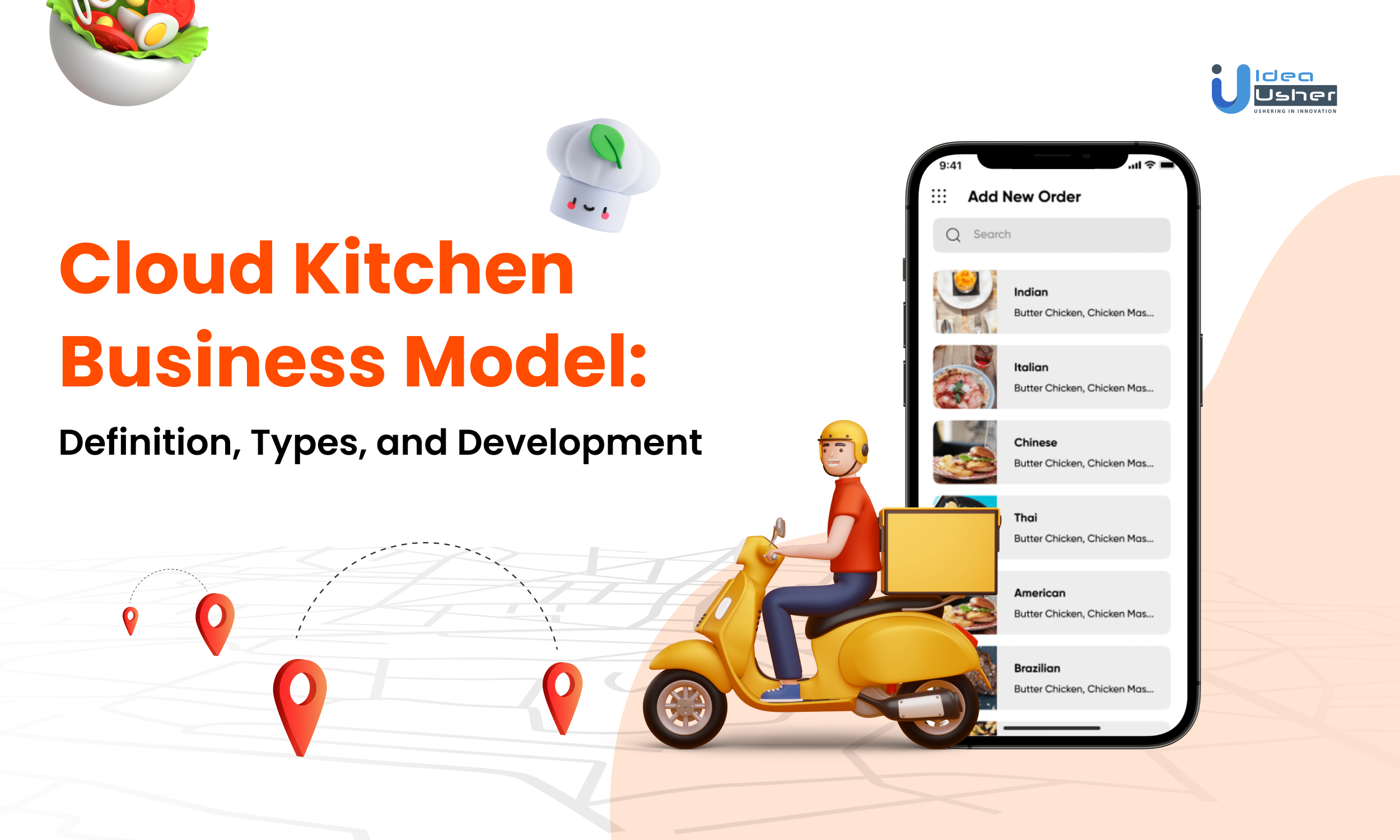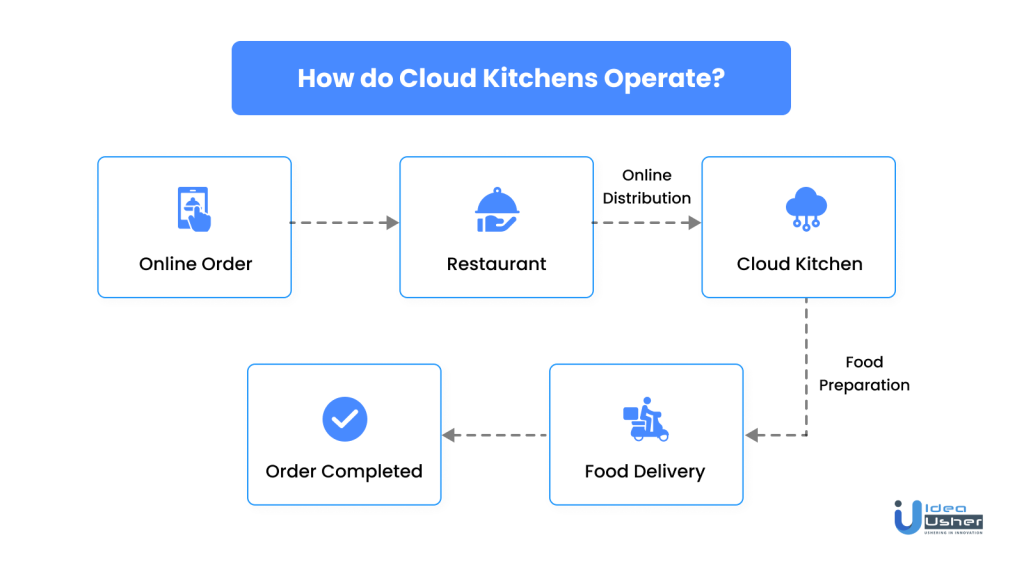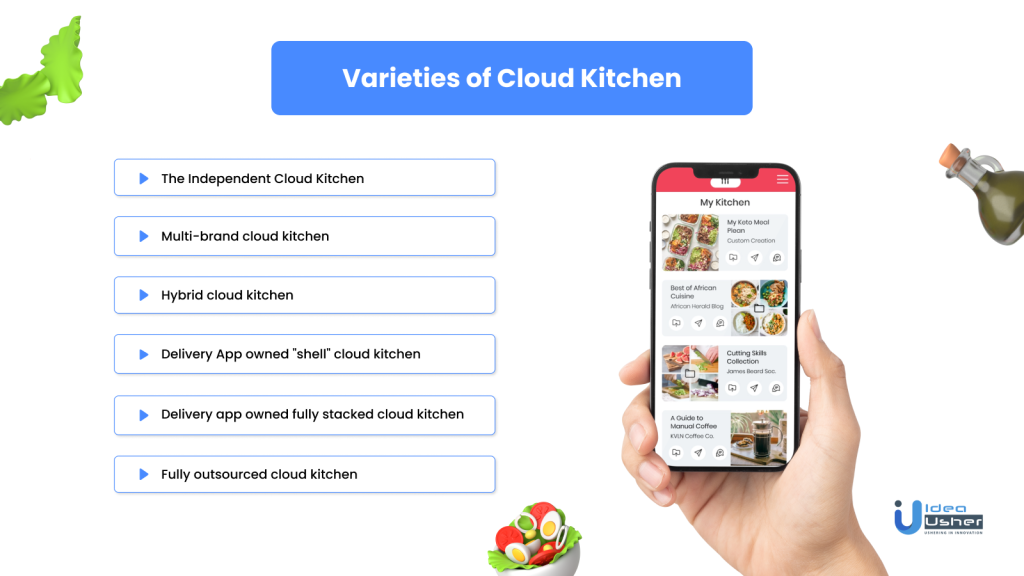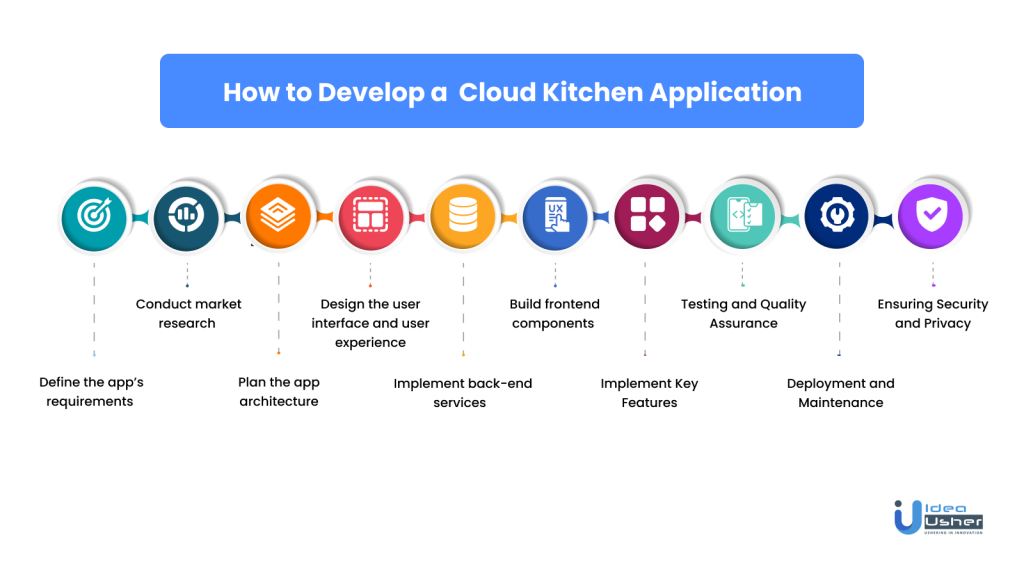- What is a Cloud Kitchen?
- How do Cloud Kitchens Operate?
- Cloud Kitchen: Revenue Model
- Varieties of Cloud Kitchen
- Top 5 Cloud Kitchens in the Market
- Advanced Features of Cloud Kitchen Applications
- Difference between Cloud Kitchen and Virtual Restaurant
- How to Develop a Cloud Kitchen Application
- Cost of Developing a Cloud Kitchen Business App
- Wrapping Up
- FAQs

In a world where technology and convenience intertwine, the culinary industry is undergoing a digital revolution. Enter the realm of cloud kitchens, where cutting-edge technology and streamlined operations are transforming the way food is prepared and delivered.
In this blog, we delve into the technical intricacies of cloud kitchens, unraveling the innovative systems and processes that make them a force to be reckoned with. Join us on a journey of culinary ingenuity as we explore the technological wonders driving the success of cloud kitchens in today’s ever-evolving dining landscape.
- What is a Cloud Kitchen?
- How do Cloud Kitchens Operate?
- Cloud Kitchen: Revenue Model
- Varieties of Cloud Kitchen
- Top 5 Cloud Kitchens in the Market
- Advanced Features of Cloud Kitchen Applications
- Difference between Cloud Kitchen and Virtual Restaurant
- How to Develop a Cloud Kitchen Application
- Cost of Developing a Cloud Kitchen Business App
- Wrapping Up
- FAQs
What is a Cloud Kitchen?
A cloud kitchen, also known as a delivery-only restaurant or virtual kitchen, is a concept in the food industry where food is prepared in a kitchen without any dine-in facilities and delivered to customers’ homes.
It is a business model that allows restaurant owners to operate without the high costs associated with a physical storefront. There are several types of cloud kitchens, including the brand-owned, additional kitchen of well-established restaurants, side hustle of already established restaurants, and shared or business-owned kitchens.
How do Cloud Kitchens Operate?

There are various kinds of cloud kitchens with their operational principles. Although, one aspect that is common in all cloud kitchens is that they only offer the home delivery of food products. Let’s comprehend this definition with the help of an example.
- Let’s say you open a cloud kitchen named “Food Fusion.” With a cloud kitchen, you can begin multiple virtual restaurant brands operating out of the same kitchen space. For example, you can create “Burger Buzz” for gourmet burgers, “Pasta Paradise” for Italian pasta dishes, and “Asian Delight” for Asian cuisine. Each brand can have its own menu, branding, and online presence.
- When a customer places an order through an online food delivery platform or your website, the order is received at the cloud kitchen. The kitchen staff then prepares the food according to the specific brand’s menu and packaging guidelines. The packaging may include branding elements such as logos and labels for “Burger Buzz,” “Pasta Paradise,” or “Asian Delight.”
- Once the food is ready, it is swiftly delivered to the customer’s location by either your own delivery drivers or through a third-party delivery service. The customer receives their order, which is associated with the brand they ordered from, such as “Burger Buzz.”
- By operating multiple brands from a single kitchen, you can cater to diverse customer preferences and increase your reach without the need for additional infrastructure or investments. This flexibility and cost-efficiency are some of the key advantages of cloud kitchens.
Cloud Kitchen: Revenue Model
here are some facts to see about revenue model
1. Brand-Owned Cloud Kitchen
A brand-owned kitchen is when one brand manages one kitchen in an area or location. Here, the brand does not refer to only big food chains but also to new players in this business setting up their kitchens.
2. Additional Kitchen of well-established restaurants
Several restaurants with dine-in facilities in one location open the cloud kitchen in multiple other locations. Therefore, it can be seen as a way for well-established restaurants to diversify their market presence and expand their customer base.
3. Side Hustle of already established restaurants
When a traditional restaurant adopts the cloud kitchen concept, they can leverage their existing kitchen facilities to create a specialized delivery-only menu. The food is prepared within the restaurant’s current kitchen and then delivered to customers located in more distant areas.
4. Shared or business-owned kitchen
Nowadays, capital owners are offering physical infrastructure to restaurant owners. They are building big kitchens in outer areas and renting them out to them. Many have different kitchen portions for brands whereas others share the same space.
Varieties of Cloud Kitchen

1. The Independent Cloud Kitchen
An independent cloud kitchen is defined as a standalone kitchen that functions solely for the purpose of preparing and delivery of food. It is not associated with any restaurant or brand and can even choose to cater to various virtual restaurant concepts or delivery-only brands simultaneously.
Operational process
- Order online
- Features a particular cuisine only
- Provides the delivery only
- Self-delivery as well as aggregators
Examples- UberEats, Doordash, and Grubhub
2. Multi-brand cloud kitchen
A multi-brand cloud kitchen is when a single facility is utilized to operate multiple virtual restaurant brands. Therefore, instead of paying attention to one single brand or concept, multi-brand cloud kitchens allow for the simultaneous functioning of various food concepts accompanied with their own particular menu, brand as well as online presence.
Operational process
- Order online
- Multiple brands from single kitchen
- Provides the delivery only
- Self-delivery as well as aggregators
Example- Rebel foods
3. Hybrid cloud kitchen
A hybrid-cloud kitchen is an amalgamation of physical dine-in restaurants and cloud kitchen operations. Under this model of cloud kitchen, an existing restaurant incorporates a cloud kitchen concept within its infrastructure to cater specifically to delivery and take-out orders.
Operational process
- Order online
- Multi-cuisine seasonal menu
- Delivery and takeaway
- Self-delivery as well as aggregators
Example- Zomato or Swiggy
4. Delivery App owned “shell” cloud kitchen
A ‘shell’ owned cloud kitchen is defined as a delivery-owned cloud kitchen that functions as a virtual kitchen without the presence of a physical restaurant space.
Operational process
- Online orders from particularly owned aggregators
- Multiple brands in partnership
- Delivery via aggregator only
Example- Zomato or Swiggy
5. Delivery app owned fully stacked cloud kitchen
It is a fully-stacked cloud kitchen that offers end-to-end services to virtual restaurant brands. Hence, in this model, the delivery-app company not only owns the cloud kitchen facility but also manages all other aspects of functioning such as food preparation, packaging, delivery logistics, etc.
Operational Process
- Online order forms particularly owned aggregator
- Option for a walk in
- Multiple brands in partnership
Example: UberEats
6. Fully outsourced cloud kitchen
In a fully outsourced kitchen model, where a third-party provider takes the central space. It means, all the integral components of an operation including kitchen facilities, staff, food preparation, and delivery logistics are outsourced to the third-party provider.
Operational process
- Order from all sources
- Cloud kitchens store the raw materials
- Pre-prepared food is sent to the cloud kitchen in the neighborhood
- Food is prepared in the secondary kitchen and delivered to the customer
Example-Kitopi
Top 5 Cloud Kitchens in the Market
list of some of the top performers in the market
1. Rebel Foods
Rebel Foods, is an Indian online restaurant with 11 cloud kitchens and is the biggest cloud kitchen in the world. It also includes big brand names such as Faasos, Oven Story, and Behrouz Biryani. The cloud kitchen brand has 450 cloud kitchens in 10 different countries.
2. CloudKitchens
Uber founder and former chief executive Travis Kalanick with the help of new investment fund 10100, has made an investment of $150 million into City Storage Systems. The investment will focus its attention on undervalued real estate. In addition to this, CloudKitchen is one of the two businesses of its holding company. Therefore, Cloud Kitchen is opening massive kitchens for restaurants willing to emerge as new players in the market.
3. Kitchen United
Kitchen United is another prominent name in the cloud kitchen industry. The business has been set up by former executives at Taco Bell and Mcdonalds’. The rapidly developing platform has recently added $40 million after its initial funding round of $10 million from GV.
4. Alldaykitchens
Alldaykitchens has announced its formal launch after gaining $15 million of Series A funding from ‘super angel’ investors, Andreessen Horowitz, and automation-focused investment firm Base10 partners. The firm already has various delivery-only kitchens based in several locations in San Francisco and currently has planned to open a dozen more in the Bay area.
5. DoorDash Kitchen
DoorDash is known as the first firm to have made a move in the cloud kitchen market. The firm has a well-established kitchen near Redwood City to help restaurant businesses scale rapidly.
Advanced Features of Cloud Kitchen Applications

1. POS System (Point Of Sale)
In the cloud kitchen, there are no waiters to take orders from customers. Therefore, a POS is a system that helps you in taking orders from customers from different channels. While working with other platforms, this feature enables you to analyze the best platform that brings you the majority of orders.
2. KDS (Kitchen Display System)
The menu of your virtual restaurant would play an essential role in attracting customers. KDS crafts the electronic menu of your restaurant to share it with your audience.
3. Courier Management System
Mobile courier management systems record all the information about food delivery with the help of AI-powered chatbots. You can easily keep track of the movement of your delivery fleets, the time they spend in one location, the routes they are taking, etc.
4. Inventory management system
An inventory management system can help you easily keep a record of products in your kitchen and ingredients that you need to restock soon. Hence, the feature ensures that you have the ingredients to prepare the whole menu you are offering.
Difference between Cloud Kitchen and Virtual Restaurant
The majority of people believe that cloud kitchens and virtual restaurants are the same, whereas there is a line of difference between the two concepts.
Cloud kitchen is a colossal commercial kitchen space in which independent chefs rent out their own spaces to cook dishes. They sell these dishes through the online marketplace. Chefs pay the rent for these kitchens.
On the other hand, virtual restaurants are online businesses owned by physical restaurant entities. When a restaurant already has a physical infrastructure and decides to use its physical sources to the best of its abilities, they introduce a menu available only for takeaway and manage it as a virtual restaurant.
How to Develop a Cloud Kitchen Application

Developing a cloud kitchen application involves several key steps and considerations from our expert app developer’s perspective we have added an insight. Here are some detailed points to guide you through the process:
1. Define the app’s requirements
The first step toward the cloud kitchen application development process is to identify the target audience you will be utilizing your application. These include:
i. Restaurant owners
If your app is intended for restaurant owners, the requirements should emphasize order management, inventory tracking, and analytics to assist them effectively manage their cloud kitchen operations.
ii. Chefs and kitchen staff
If your app is for chefs and kitchen staff then its app features can include recipe management, ingredient tracking as well as communication tools to make kitchen operations seamless.
iii. Customers
For customers, the app can include features like browsing menus, placing orders, tracking deliveries, making payments, and leaving reviews to offer users a satisfying experience.
iv. All of the above
It is quite possible to develop an app that caters to multiple users. Therefore, in such cases, businesses would need to analyze the needs of each audience group to integrate functions accordingly.
Apart from this, other components that are crucial is to determine the app’s purpose which involves the main functionality that app will serve such as order management, menu customization, delivery tracking etc.
Once the aspects given above, target audience and app’s primary purpose are considered, you can decide on the platform you want to develop your app on. The decision is crucial as it determines your app’s reach and engagement with the audience along with the development approach, and resources needed.
2. Conduct market research
The next step of the app development process is to conduct in-depth market research and while at it, consider the following:
i. Current market trends and competition
Stay fully informed about the latest trends and developments in the cloud kitchen industry. Comprehend the competitive landscape by finding the existing cloud kitchen apps and studying their offerings, pricing models and target markets.
ii. Analysis of existing apps
Analyze the existing cloud kitchen competitors in the market to find about their strengths, weaknesses, and the mistakes they made so that you can avoid making the same in this field in the future.
iii. Unique features and functionalities
Identify novel features and functionalities that set your app apart from others in the market. This could include features like innovative order management systems, personalized menu customization options integration with popular food delivery platforms and even exclusive collaborations with local vendors.
3. Plan the app architecture
Once you are done with the research, you need to lay out your application’s architecture. For this step, consider the following:
i. High-level architecture
Make a clear and concise well-defined architectural design for your application. It includes recognizing the server-side components such as APIs, databases, and establishing how they will interact to provide the support to app’s functionality and management.
ii. Native app and cross-platform development
Decide whether you will develop a native app or leverage cross-development platforms such as React Native or Flutter.
- Native app: Developing a native-app involves using platform-specific technologies and programming languages like Swift or Objective-C for iOS, and Java or Kotlin for Android.
- Cross-platform development: Cross-platform frameworks like React Native or Flutter allow you to build a single codebase that can be deployed to multiple platforms.
4. Design the user interface and user experience
Designing the user interface (UI) and the user experience (UE) are equally important components of your app development process. For this aspect, focus on the following:
i. Wireframes and prototypes
Curate wireframes and prototypes to visualize the app’s architecture or layout, navigation flow as well as interactions. It helps in planning the structure and functionality of the app.
ii. Intuitive and visually appealing UI and seamless user experience
The design interface needs to be visually appealing, easy-to-navigate through and user-friendly and all of these aspects should reflect your brand. In addition to this, the app should focus on making the user experience seamless by simplifying complex processes such as ordering, payment, and tracking.
5. Implement back-end services
Several technologies are used to build a cloud kitchen app such as Node.js and Express.js, Ruby on Rails, Python and Django, Firebase, etc. Therefore, before integrating them, consider the following:
i. Server-side components
Develop the backend components that manage the app’s business logic, data storage, and APIs. It involves curating APIs for communication between the client-side app and server, implementing algorithms for order management. In addition to this, ensure sufficient data storage and retrieval.
ii. Secure and scalable infrastructure
Build a secure and scalable infrastructure as it would be responsible for user registrations, authentication, and authorization. Integrate mechanisms such as encryption, secure communication protocols as well as user access controls to shield user data and ensure data privacy.
iii. Third-party service integration
Associate with third-party services to improve the app’s functionality. It involves adding payment gateways for secure transactions, map APIs for location tracking and delivery routing, and SMS gateways for order notifications, and communication.
6. Build frontend components
When it comes to developing the frontend of a cloud kitchen app, there are different technologies that developers can opt for such as React.js, Vue.js, and AngularJS. When it comes to building the frontend components, the following aspects need to be paid attention to:
i. Choose suitable technologies like Swift, Java/Kotlin, or React Native for implementing the frontend components based on your target platforms such as Android or iOS or both.
ii. Prioritize responsive design to make sure that your app looks and functions seamlessly across various devices and screen sizes. It ultimately enhances the user experience and accessibility.
iii. Implement real-time features like order tracking or chat functionality using technologies like WebSockets or Firebase. These technologies allow instant communication and updates between the app and users, offering a seamless and interactive experience.
7. Implement Key Features
To successfully run a cloud kitchen, it is necessary for your application to have robust and effective features to streamline operations and enhance the overall user experience. Some key features that you must implement are given below:
i. User Registration and Authentication
Allow users to securely create accounts, log in, and manage their profiles for personalized experiences.
ii. Menu Management
Enable restaurant owners or chefs to easily create, update, and customize menus through item descriptions, prices as well as appealing images.
iii. Ordering and Payment
Implement a seamless ordering process that allows users to add items to their cart, choose payment methods, and make payments in a secure manner.
iv. Order Tracking and Notifications
Provide real-time updates to customers about their order status and estimated delivery time to keep them informed and engaged.
v. Delivery Partner Integration
Associate with delivery service providers or build an in-house fleet management system to efficiently handle delivery logistics and ensure smooth order fulfillment.
8. Testing and Quality Assurance:
i. Rigorous Testing
Conduct thorough testing to ensure the app functions smoothly without any bugs hindering its performance.
ii. Manual and Automated Testing
Utilize both manual and automated testing approaches to identify and address any issues in the app’s functionality, performance, and user interface.
iii. Gather User Feedback
Engage beta testers or early users to gather valuable feedback on the app’s stability, usability, and overall user experience. Utilize this feedback to make necessary updates and improvements to enhance the app’s quality and user satisfaction.
9. Deployment and Maintenance
i. Prepare for Deployment
Arrange the app store listings, make developer accounts, and generate the required certificates to ensure a smooth deployment process.
ii. Monitor Performance and User Feedback
Continuously monitor the app’s performance, keep track of user feedback, and acknowledge any reported issues to maintain a positive user experience.
iii. Regular Updates and Enhancements
Continuously update and enhance the app based on user feedback, industry trends, and evolving customer needs. It ensures that your app remains relevant, competitive, and aligned with the changing demands of your target audience.
10. Ensuring Security and Privacy
i. Implement Robust Security Measures
Implement strong security measures such as encryption, secure APIs, and proper access controls to shield user data from unauthorized access or frauds and breaches.
ii. Comply with Data Protection Regulations
Adherence to relevant data protection regulations like GDPR (General Data Protection Regulation) or CCPA (California Consumer Privacy Act) is integral to protect user privacy and obtain appropriate consent for data collection and processing. It showcases your commitment to maintaining user trust and complying with legal requirements.
Cost of Developing a Cloud Kitchen Business App
The cost of developing a cloud kitchen business app can vary depending on various factors such as the complexity of the app, the desired features and functionalities, the platforms it will be developed for (iOS, Android, web), the development team’s location and rates as well as the overall project scope.
Wrapping Up
In conclusion, venturing into the world of cloud kitchen business apps is a complex endeavor that requires careful planning and execution. The technical challenges, operational considerations, and market dynamics involved make it imperative to partner with the right development team.
That’s where Idea Usher comes in. With our expertise in app development and deep understanding of the cloud kitchen industry, we are the ideal choice to bring your vision to life. Whether you aim to create a powerful ordering platform, optimize kitchen operations, or enhance customer engagement, our team is ready to provide you with tailored solutions. Don’t settle for anything less than excellence. Choose Idea Usher for your cloud kitchen app development needs and embark on a successful journey in this thriving industry.
Contact Idea Usher today!
Email: [email protected]
Phone: (+1) 732 962 4560
(+91) 859 140 7140
FAQs
Q. What exactly is a cloud kitchen?
ANS: A cloud kitchen, also known as a ghost kitchen or virtual kitchen, is a delivery-centric food production facility that operates without a physical dine-in space. It is specifically designed to prepare meals for delivery or takeout orders from various virtual restaurant brands or delivery platforms.
Q. How does the cloud kitchen business model work?
ANS: In the cloud kitchen business model, kitchen facilities are shared among multiple virtual restaurant brands or delivery-only concepts. Orders are received through online platforms or mobile apps, and the kitchen staff prepares the food according to each brand’s menu. The packaged meals are then delivered to customers through in-house delivery teams or third-party delivery services.
Q. What are the advantages of the cloud kitchen business model?
ANS: The cloud kitchen business model offers several advantages. It eliminates the high costs associated with operating a physical restaurant, such as rent and seating capacity. It allows for easy scalability and experimentation with different restaurant concepts. Additionally, cloud kitchens can reach a wider customer base by catering to various delivery platforms, maximizing revenue potential.
Q. How can Idea Usher help you in developing a cloud kitchen business app?
ANS: Idea Usher’s expertise in app development and deep understanding of the cloud kitchen industry are the ideal choice to bring your vision to life. We can help you develop a customized cloud kitchen business app with a user-friendly interface and a robust backend system to efficiently manage orders, track inventory, and streamline operations.









Vrinda Sharma